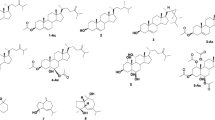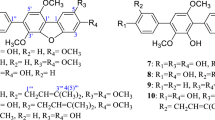Abstract
A soft coral-derived fungus Penicillium sp. among other isolates e high antibacterial, anti-yeast and cytotoxic activities. The fungus, Penicillium sp. MMA, isolated from Sarcphyton glaucoma, afforded nine diverse compounds (1–9). Their structures were identified by 1D and 2 D NMR and ESI–MS spectroscopic data as two alkaloids: veridicatol (1), aurantiomide C (2); one sesquiterpene, aspterric acid (3); two carboxylic acids, 3,4-dihydroxy-benzoic acid; (4) and linoleic acid (5); three steroids, ergosterol (6), β-Sitosterol (7), β-Sitosterol glucoside (8) along with the sphingolipid, cerebroside A (9). Biologically, the antimicrobial, antioxidant, in vitro cytotoxicity and antibiofilm activities were studied in comparison with the fungal extract. The in silico computational studies were implemented to predict drug and lead likeness properties for 1–4. The fungus was taxonomically characterized by morphological and molecular biology (18srRNA) approaches.





Similar content being viewed by others
References
Abdel-Razek AS, El-Awady M, Hassan AZ, Yassin FY, Asker M, Shaaban M (2017) Bioactive compounds from marine Stachybotrys sp. QL23. IJNPR 8:322–328
Atta KFM, Farahat OOM, Al-Shargabi TQ, Marei MG, Ibrahim TM, Bekhit AA, El Ashry EH (2019) Syntheses and in silico pharmacokinetic predictions of glycosylhydrazinyl-pyrazolo[1,5-c]pyrimidines and pyrazolo[1,5-c] triazolo[4,3-a]pyrimidines as anti-proliferative agents. Med Chem Res 28:215–227
Austin DJ, Myers MB (1964) 3-O-methylviridicatin, a new metabolite from Penicillium puberulum. J Chem Soc 1:1197–1198
Bara R, Zerfass I, Aly AH, Goldbach-Gecke H, Vijay R, Sass P, Mandi A, Wray V, Polavarapu PL, Pretsch A, Lin WH, Kurtan T, Debbab A, Broetz-Oesterhelt H, Proksch P (2013) Atropisomeric dihydroanthracenones as inhibitors of multi-resistant Staphylococcus aureus. J Med Cchem 56:3257–3272
Barreto-Bergter E, Sassaki GL, de Souza LM (2011) Structural analysis of fungal cerebrosides. Front Microbiol 5:239
Bauer AW, Kirby WM, Sherris JC, Truck M (1966) Antibiotic susceptibility testing by a standardized single disk method. Am J Clin Pathol 45:493–496
Baur AC, Kuehn J, Brandsch C, Hirche F, Stangl GI (2019) Intake of ergosterol increases the vitamin D concentrations in serum and liver of mice. J Steroid Biochem 194:105435
Bennett JM, Catovsky D, Danniel MT, Galton DAG, Graanlink HR, Sultan C (1976) Proposal for the classification of the acute leukamias. Br J Haemtol 33:451–458
Blunt JW, Copp BR, Hu WP, Munro MH, Northcote PT, Prinsep MR (2007) Marine natural products. Nat Prod Rep 24:31–86
Branda SS, Vik S, Friedman L, Kolter R (2005) Biofilms: The matrix revisited. Trends Microbiol 13:20–26
Brand-Williams W, Cuvelier ME, Berset C (1995) Use of a free radical method to evaluate antioxidant activity. Lebensm Wiss Technol 28:25–30
Chapman MR, Robinson LS, Pinkner JS, Roth R, Heuser J, Hammar M, Normark S, Hultgren SJ (2002) Role of Escherichia coli curli operons in directing amyloid fiber formation. Science 295:851–855
Christensen GD, Simpson WA, Younger JJ, Baddour LM, Barrett FF, Melton DM (1985) Adherence of coagulase-negative staphylococci to plastic tissue culture plates: a quantitative model for the adherence of staphylococci to medical devices. J Clin Microbiol 22:996–1006
Ciegler A, Kadis S, Ajl SJ (1971) Microbial toxins: a comprehensive treatise; fungal toxins. Metabolites of Penicillium viridicatum and closely related species. Copyright by Academic press, INC 111 Fifth Avenue, New York 10003, Vol VI, p 509
Daina A, Zoete V (2016) A BOILED-egg to predict gastrointestinal absorption and brain penetration of small molecules. Chem Med Chem 11:1117–1121
Daina A, Michielin O, Zoete V (2017) Swiss ADME: a free web tool to evaluate pharmacokinetics, drug-likeness and medicinal chemistry friendliness of small molecules. Sci Rep 7:42717–42730
Debbab A, Aly AH, Edrada-Ebel R, Müller WEG, Mosaddak M, Hakiki A, Proksch P, Ebel R (2009) Bioactive secondary metabolites from the endophytic fungus Chaetomium sp. isolated from Salvia officinalis growing in Morocco. Biotechnol Agron Soc Environ 13:229–234
Donlan RM, Costerton JW (2002) Biofilms: survival mechanisms of clinically relevant microorganisms. Clin Microbiol Rev 15:167–193
Drwal MN, Banerjee P, Dunkel M, Wettig MR, Preissner R (2014) ProTox: a web server for the in-silico prediction of rodent oral toxicity. Nucleic Acids Res 42:53–W58
El-awady ME, Boulis AG, Attia AR, Shaaban M (2019) Dimeric Naphtho-gamma-pyrones and further diverse bioactive metabolites from the marine-derived Aspergillus flavus Af/MMA 2018. Egypt Pharmaceut J 18:245–253
Frisvad JC, Smedsgaard JL, Larsen TO, Samson RA (2004) Mycotoxins, drugs and other extrolites produced by species in Penicillium subgenus Penicillium. Stud Mycol 49:201–241
Gaullier JM, Halse J, Hoye K, Kristiansen K, Fagertun H, Vik H, Gudmundsen O (2005) Supplementation with conjugated linoleic acid for 24 months is well tolerated by and reduces body fat mass in healthy overweight humans. J Nutr 135:778–784
Gautam SS, Navneet KS (2012) The antibacterial and phytochemical aspects of Viola odorata Linn. extracts against respiratory tract pathogens. Proc Natl Acad Sci India B Biol Sci 82:567–572
Haefner B (2003) Drugs from the deep: Marine natural products as drug candidates. Drug discov Today 8:536–544
Dictionary of Natural Products on CD-ROM (2018) Chapman & Hall Chemical Database
Hamed A, Ismail M, El-Metwally MM, Frese M, Ibrahim TMA, El-Haddad AF, Sewald N, Shaaban M (2019) Diverse Polyketides and alkaloids from Penicillium sp. KHMM: structure elucidation, biological and molecular docking studies. Z Naturforsch C 74:131–137
Hamed AA, Kabary H, Khedr M, Emam AN (2020) Antibiofilm, antimicrobial and cytotoxic activity of extracellular green-synthesized silver nanoparticles by two marine-derived actinomycete. RSC Adv 10:10361–10367
Hardoim PR, van Overbeek LS, Berg G, Pirttilä AM, Compant S, Campisano A, Döring G, Sessitsch A (2015) The hidden world with in plants: ecological and evolutionary considerations for defining functioning of microbial endophytesThe hidden world with in plants: ecological and evolutionary considerations for defining functioning of microbial endophytes. Microbiol Mol Biol Rev 79:293–320. https://scifinder.cas.org/scifinder/view/scifinder/scifinderExplore.jsf
Kaul S, Gupta S, Ahmed M, Dhar MK (2012) Endophytic fungi from medicinal plants: a treasure hunt for bioactive metabolites. Phytochem Rev 11:487–505
Kawai J, Mori K, Hirasawa N (2019) Grifola frondosa extract and ergosterol reduce allergic reactions in an allergy mouse model by suppressing the degranulation of mast cells. Biosci Biotechnol Biochem 83:2280–2287
Koga J, Yamauchi T, Shimura M, Ogawa N, Oshimai K, Umemura K, Kikuchi M, Ogasawara N (1998) Cerebrosides A and C, sphingolipid elicitors of hypersensitive cell death and phytoalexin accumulation in rice plants. J Biol Chem 273:31985–31991
Kontogiorgis CA, Bompou EM, Ntella M, Berghe WV (2010) Natural products from mediterranean diet: from anti-inflammatory agents to dietary epigenetic modulators. Anti Inflamm Anti-Allergy Agents Med Chem 9:101–124
Leitão AL (2009) Potential of Penicillium species in the bioremediation field. Int J Environ Res Public Health 6:1393–1417
Li W-Y, Chan S-W, Guo D-J, Yu PH-F (2007) Correlation between antioxidative power and anticancer activity in herbs from traditional chinese medicine formulae with anticancer therapeutic effect. Pharm Biol 45:541–546
Liang Z-Y, Shen N-X, Zheng Y-Y, Wu J-T, Miao L, Fu X-M, Chen M, Wang C-Y (2019) Two new unsaturated fatty acids from the mangrove rhizosphere soil-derived fungus Penicillium javanicum HK1-22. Bioorg Chem 93:103331
Luckner M, Mothes K (1962) On the biosynthesis of 2,3-dihydroxy-4-phenyl-quinoline viridicatin. Tetrahedron Lett 3:1035–1039
Melariri P, Campbell W, Etusim P, Smith P (2012) In vitro and in vivo antimalarial activity of linolenic and linoleic acids and their methyl esters. Adv Stud Biol 4:333–349
Mosmann T (1983) Rapid colorimetric assay for cellular growth and survival: application to proliferation and cytotoxicity assays. J Immunol Methods 65:55–63
Nagia MMS, El-Metwally MM, Shaaban M, El-Zalabani SM, Hanna AG (2012) Four butyrolactones and diverse bioactive secondary metabolites from terrestrial Aspergillus flavipes MM2: isolation and structure determination. Org Med Chem Lett 2:1–8
Nicoletti R, Trincone A (2016) Bioactive compounds produced by strains of penicillium and talaromyces of marine origin. Mar Drugs 14:37
Patjana T, Jantaharn P, Katrun P, Mongkolthanaruk W, Suwannasai N, Senawong T, Tontapha S, Amornkitbumrung V, McCloskey S (2019) Anti-inflammatory and cytotoxic agents from Xylaria sp. SWUF09-62 fungus. Nat Prod Res. https://doi.org/10.1080/14786419.2019.1652292
Pejin B, Jovanovi KK, Mojovic M, Savic AG (2013) New and highly potent antitumor natural products from marine-derived fungi: covering the period from 2003 to 2012. Curr Top Med Chem 13:2745–2766
Peshin T, Kar HK (2017) Isolation and characterization of β-sitosterol-3-O-β-D-glucoside from the extract of the flowers of Viola odorata. Br J Pharm Res 16:1–8
Pimentel MR, Molina G, Dionisio AP, Maróstica MR, Pastore GM (2011) Use of endophytes to obtain bioactive compounds and their application in biotransformation process. Biotechnol Res Int 576:286
Potts RO, Guy RH (1992) Predicting skin permeability. Pharm Res 9:663–669
Rabin N, Zheng Y, Opoku-Temeng C, Du Y, Bonsu E, Sintim HO (2015) Biofilm formation mechanisms and targets for developing antibiofilm agents. Future Med Chem 7:493–512
Rutkowska E, Pajak K, Jozwiak K (2013) Lipophilicity-methods of determination and its role in medicinal chemistry. Acta Pol Pharm 70:3–18
Saleem M, Ali MS, Hussain S, Jabbar A, Ashraf M, Lee YS (2007) Marine natural products of fungal origin. Nat Prod Rep 24:1142–1152
Sarasan M, Puthumana J, Job N, Han J, Lee J-S, Philip R (2017) Marine algicolous endophytic fungi-a promising drug resource of the era. J Microbiol Biotechnol 27:1039–1052
Shaaban M (2004) Bioactive secondary metabolites from marine and terrestrial bacteria: isoquinolinequinones, bacterial compounds with a novel pharmacophor. Ph.D. Thesis, Georg-August University, Göttingen, Germany
Shaaban M, Sohsah GE, El-Metwally MM, Elfedawy MG, Abdel-Mogib M (2016) Bioactive compounds produced by strain of Penicillium sp. IJSEA 5:7560
Shimada A, Kusano M, Takeuchi S, Fujioka S, Inokuchi T, Kimura Y (2002) Aspterric acid and 6-hydroxymellein, inhibitors of pollen development in Arabidopsis thaliana, produced by Aspergillus terreus. Z Naturforsch 57:459–464
Steinberg N, Kolodkin-Gal I (2015) The matrix reloaded: probing the extracellular matrix synchronizes bacterial communities. J Bacteriol 197:2092–2103
Suryanarayanan TS (2012) The diversity and importance of fungi associated with marine sponges. Bot Mar 55:553–564
Syafni N, Putra DP, Arbain D (2012) 3,4-Dihydroxybenoic acid and 3,4-dihydroxybenzaldehyde from the Fern Trichomanes chinense L.; isolation, antimicrobial and antioxidant properties. Indo J Chem 12:273–278
Undurti ND (2008) Can essential fatty acids reduce the burden of disease(s)? Lipids Health Dis 7:1–5
Vuppala PK, Janagam DR, Balabathula P (2013) Importance of ADME and bioanalysis in the drug discovery. J Bioequiv Availab 5:1–2
Walters D, Raynor L, Mitchell A, Walker R, Walker K (2004) Antifungal activities of four fatty acids against plant pathogenic fungi. Mycopathologia 157:87–90
Wingender J, Flemming HC (2011) Biofilms in drinking water and their role as reservoir for pathogens. Int J Hyg Environ Health 214:417–423
Xia Y, Amna A, Opiyo SO (2018) The culturable endophytic fungal communities of switchgrass grown on a coalmining site and their effects on plant growth. PLoS ONE 13:1–16
Xin Z, Fang Y, Du L, Zhu T, Duan L, Chen J, Gu Q, Zhu W (2007) Aurantiomides A-C, quinazoline alkaloids from the sponge-derived fungus Penicillium aurantiogriseum SP0-19. J Nat Prod 70:853–855
Yan Y, Liu Q, Zang X, Yuan S, Bat-Erdene U, Nguyen C, Gan J, Zhou J, Jacobsen SE, Tang Y (2018) Resistance-gene-directed discovery of a natural-product herbicide with a new mode of action. Nature 559:415–418
Yin W, Keller NP (2011) Transcriptional regulatory elements in fungal secondary metabolism. J Microbiol 49:329–339
Youssef DTA, Ibrahim SRM, Shaala LA, Mohamed GA, Banjar ZM (2016) New cerebroside and nucleoside derivatives from a red sea strain of the marine cyanobacterium moorea producens. Molecules 21:324
Yu G, Sun Z, Peng J, Zhu M, Che Q, Zhang G, Zhu T, Gu Q, Li D (2019) Secondary metabolites produced by combined culture of Penicillium crustosum and a Xylaria sp. J Nat Prod 82:2013–2017
Acknowledgements
The authors are deeply thankful to Prof. H. Laatsch, Institute of Organic and Biomolecular Chemistry, Göttingen, for his support and lab facilities. We thank Dr. H. Frauendorf and Dr. M. John for MS and NMR measurements. M. Shaaban thanks the German Academic Exchange Service (DAAD) for a Postdoc short-term grant.
Author information
Authors and Affiliations
Corresponding author
Ethics declarations
Conflict of interest
The authors declare that they have no conflict of interest.
Additional information
Communicated by Erko Stackebrandt.
Publisher's Note
Springer Nature remains neutral with regard to jurisdictional claims in published maps and institutional affiliations.
Electronic supplementary material
Below is the link to the electronic supplementary material.
Rights and permissions
About this article
Cite this article
Boulis, A.G., Hamed, A.A., El-awady, M.E. et al. Diverse bioactive metabolites from Penicillium sp. MMA derived from the red sea: structure identification and biological activity studies. Arch Microbiol 202, 1985–1996 (2020). https://doi.org/10.1007/s00203-020-01923-x
Received:
Revised:
Accepted:
Published:
Issue Date:
DOI: https://doi.org/10.1007/s00203-020-01923-x




